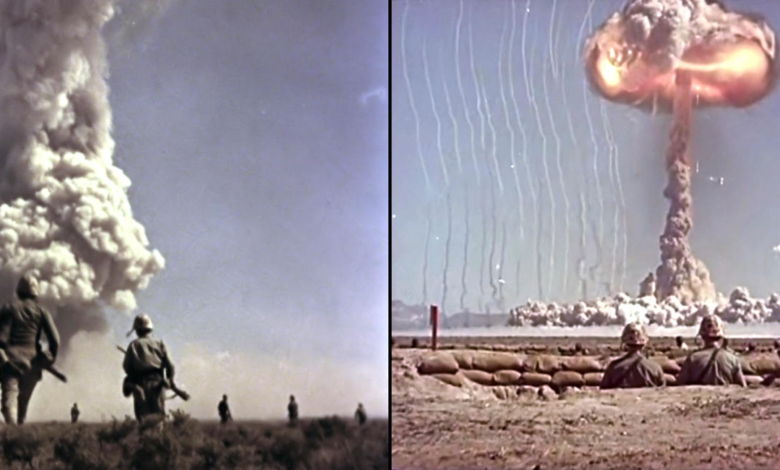Unveiling the C38 Atomic Bomb: A Comprehensive Guide

Inleiding tot de C38-atoombom
Op het gebied van de militaire geschiedenis en technologische vooruitgang hebben weinig creaties een zo diepgaande impact achtergelaten als de C38-atoombom. De C38 Atoombom, ontwikkeld tijdens een periode van intense mondiale conflicten en wetenschappelijke innovatie, is een bewijs van het vermogen van de mensheid tot zowel vernietiging als innovatie.
De oorsprong begrijpe
Het ontstaan van de C38 Atoombom gaat terug tot de tumultueuze jaren van de Tweede Wereldoorlog, waarin het Manhattan Project, een uiterst geheime onderneming, de kracht van atoomenergie probeerde te benutten voor militaire toepassing. Onder leiding van vooraanstaande wetenschappers als Robert Oppenheimer en Enrico Fermi culmineerde het project in de succesvolle test van de eerste atoombom in juli 1945, waardoor de loop van de geschiedenis voor altijd veranderde.
De technische specificaties
1. Design and Construction
The C38 Atomic Bomb represents a pinnacle of engineering and scientific achievement. Constructed with precision and meticulous attention to detail, this weapon of mass destruction embodies a fusion of cutting-edge technology and strategic ingenuity.
2. Payload and Yield
Central to the potency of the C38 Atomic Bomb is its formidable payload. Armed with a nuclear warhead boasting an unparalleled yield, this weapon possesses the capacity to unleash devastation on a catastrophic scale, leaving a lasting impact on both the physical and psychological landscape of its target.
Deployment and Impact
1. Historical Significance
The deployment of the C38 Atomic Bomb marked a pivotal moment in human history, forever altering the geopolitical landscape and reshaping the dynamics of global power. The bombings of Hiroshima and Nagasaki serve as stark reminders of the catastrophic consequences wrought by the unleashing of nuclear weaponry.
2. Legacy and Controversies
In the aftermath of World War II, the legacy of the C38 Atomic Bomb continues to reverberate across generations. Its use remains a subject of intense debate and moral scrutiny, with proponents and detractors alike grappling with the ethical implications of nuclear warfare.
C38 Atomic Bomb: Unveiling the Power of Nuclear Warfare
The C38 Atomic Bomb, a pinnacle of destructive power, stands as a symbol of humanity’s foray into the realm of nuclear warfare. In this article, we delve into its origins, technical specifications, impact, controversies, and its lasting legacy on the world stage.
Development and History
The origins of the C38 project
The C38 project emerged amidst the backdrop of World War II, driven by the escalating arms race between global powers. Spearheaded by a team of brilliant scientists, it aimed to harness the energy of the atom for military purposes.
Key players and scientists involved
Prominent figures such as Albert Einstein, Enrico Fermi, and J. Robert Oppenheimer played pivotal roles in the development of the C38 Atomic Bomb. Their groundbreaking research paved the way for its eventual creation.
Timeline of development
The project’s timeline is marked by significant milestones, from the discovery of nuclear fission to the successful test detonation of the C38 bomb. Each step forward brought humanity closer to unlocking the devastating potential of atomic energy.
Technical Specifications
Size and weight
The C38 bomb was a marvel of engineering, with a compact design optimized for maximum destructive force. Despite its small size, it packed a staggering amount of explosive power.
Yield and destructive power
With a yield equivalent to millions of tons of TNT, the C38 bomb possessed unparalleled destructive capabilities. Its detonation could level entire cities and inflict widespread devastation on a scale never before seen in warfare.
Delivery methods
The bomb could be delivered via various means, including strategic bombers and ballistic missiles. This versatility ensured that no target was beyond reach, further amplifying its potency as a weapon of mass destruction.
Impact and Significance
Role in warfare
The deployment of the C38 bomb forever changed the landscape of warfare, ushering in a new era of uncertainty and fear. Its mere existence altered the calculus of military strategy and forced nations to reevaluate their approach to international conflict.
Influence on geopolitical landscape
The C38 bomb exerted a profound influence on global politics, shaping alliances and rivalries in the post-war world. The specter of nuclear annihilation cast a shadow over diplomatic relations, heightening tensions between nuclear-armed nations.
Controversies and Ethical Considerations
Debate over use in warfare
The decision to deploy the C38 bomb remains a subject of intense debate and moral scrutiny. While some argue it was a necessary measure to end the war and save lives, others condemn it as an unjustifiable act of mass destruction.
Long-term effects on environment and human health
The aftermath of nuclear detonations is fraught with long-term consequences, including radioactive contamination and genetic mutations. The environmental and humanitarian toll of such weapons underscores the ethical imperative to prevent their use in future conflicts.
Legacy and Lessons Learned
Historical reflections
The legacy of the C38 bomb serves as a sobering reminder of humanity’s capacity for both innovation and destruction. Its shadow looms large over subsequent generations, prompting soul-searching and introspection on the nature of warfare and power.
Implications for future technology and policy
The lessons learned from the development and deployment of the C38 bomb have profound implications for future technological advancements and international relations. They underscore the urgent need for global cooperation and nuclear disarmament to ensure a secure and peaceful world for generations to come.
Conclusion
The C38 Atomic Bomb stands as a testament to humanity’s boundless ingenuity and its darkest impulses. Its creation and use forever altered the course of history, leaving an indelible mark on the collective consciousness of mankind. As we confront the challenges of the present and the uncertainties of the future, may we heed the lessons of the past and strive for a world free from the specter of nuclear annihilation.
FAQs (Frequently Asked Questions)
- Was the C38 bomb ever used in warfare?
- No, the C38 bomb was never deployed in combat. However, its development and testing played a crucial role in shaping the course of World War II and subsequent global conflicts.
- What was the primary motivation behind the development of the C38 bomb?
- The primary motivation was to gain a strategic advantage in warfare by harnessing the immense power of nuclear fission. The project was driven by fears of Nazi Germany developing similar weapons and the desire to end the war quickly.
- What were the long-term effects of the C38 bomb on the environment and human health?
- The detonation of atomic bombs, including the C38, resulted in widespread environmental damage and long-term health consequences due to radioactive fallout. These effects continue to be felt in affected regions to this day.
- Are there any efforts underway to prevent the proliferation of nuclear weapons?
- Yes, there are ongoing efforts by the international community to prevent the spread of nuclear weapons through treaties such as the Nuclear Non-Proliferation Treaty (NPT) and diplomatic negotiations aimed at disarmament.
- What lessons can we learn from the development and use of the C38 bomb?
- The development and use of the C38 bomb underscore the need for responsible stewardship of technological advancements and the importance of diplomacy in resolving conflicts. It also highlights the catastrophic consequences of unchecked militarism and the imperative of pursuing peaceful alternatives.



